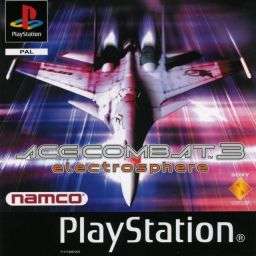Ace Combat 3: Electrosphere
| Ace Combat 3: Electrosphere | |
|---|---|
|
PAL cover art | |
| Developer(s) | Namco |
| Publisher(s) | Namco |
| Distributor(s) |
‹See Tfd› |
| Director(s) |
Takuya Iwasaki Atsushi Shiozawa |
| Producer(s) | Takashi Fukawa |
| Composer(s) |
Tetsukazu Nakanishi Koji Nakagawa Hiroshi Okubo Go Shiina Kanako Kakino Tomoko Tatsuta |
| Series | Ace Combat |
| Platform(s) | PlayStation |
| Release date(s) |
‹See Tfd›
‹See Tfd›
‹See Tfd›
|
| Genre(s) | Arcade, Combat Flight Simulator |
| Mode(s) | Single-player |
Ace Combat 3: Electrosphere (エースコンバット3 エレクトロスフィア Ēsu Conbatto San Erekutorosufia) is a flight simulation game made by Namco for the PlayStation game console. The third installment in the Ace Combat series of console flight simulation games, Electrosphere takes off the contemporary setting of the first two games into a story set in the mid-21st century, involving a war between multinational corporations.
Plot
The plot, which takes place on the Usean continent sometime in the first half of 2040,[1][2] involves two megacorporations – Neucom Inc and General Resources Ltd. These two companies fight over territorial disputes and eventually a prototype fighter known as the X-49 Night Raven, with the Universal Peace Enforcement Organization trying to placate both sides.
Gameplay
The game features a single-player mode, where the player can open a new campaign under a specific username. Depending on actions made at some points in the campaign, the plot shifts towards one of five endings. Some walkthroughs can be finished on disc one, but longer campaigns will continue in disc two. The game introduced a third-person 360-degree camera that could be rotated on all three axes with the right thumbstick, and a camera that can focus on the player's current target by holding the Triangle button. While the five endings concern the final fates of certain characters, a sixth ending suggests that the game itself is a simulation program, and the success of which forces the program creator to delete all files.
The player's performance in each mission is graded from A to D with corresponding colors, A being the highest at red. The title screen also has a chart where the player's performance across all missions and difficulties is logged.
The Japanese version of the game contains an in-game encyclopedia where the player can view various information on the game's characters and technology. It also features anime-style video e-mails with full voiceovers from non-player characters, which can be replayed in an inbox, as well as anime cutscenes.
Aircraft
The game has 23 playable aircraft (21 for the North America/Europe version) spread out across four factions. Some of them are real-world military aircraft that have been redesigned specifically for the game's futuristic setting (with the most obvious aesthetic being the heavily-streamlined cockpit area to reflect the so-called COFFIN cockpit system), while others are all-original concept designs. Space vehicles became playable for the first time in the series, with players getting to fly the R-352 Sepia spaceplane for one orbital mission.
Unlike the first two games, however, players can only choose a limited number of planes (and weapons) for the first few missions, but will stick only to one plane for the latter stages. All flyable planes are eventually unlocked in the Mission Simulator, which is activated when all endings in the game have been obtained.
Characters
Development history
The game was an attempt to explore the future of the Ace Combat universe. Concept images first surfaced in 1998 and continued through early 1999.
The majority of the songs were done by Tetsukazu Nakanishi, who would later go on to contribute background music for most of the succeeding Ace Combat console games.
The Japanese version of the game was released on May 27, 1999. Along with the 26-page instruction manual, this contained a 30-page booklet called "Ace Combat 3 Electrosphere Portfolio Photosphere," which details the game's characters, fighter planes, and other information about the game world. The "PlayStation the Best" reissue did not contain this booklet. The original game was later re-released for the Japanese market on December 7, 2000 as part of Namco's "PlayStation the Best" line of best-selling PSOne games.
Ace Combat 3 takes place in Namco's United Galaxy Space Force universe, which also includes many of their previous science-fiction games.[3]
Reception
On release, Famitsu magazine scored the game a 31 out of 40.[4]
GameSpot graded the North American release at 6.2 out of 10. Reviewer James Mielke said the game's high production values were evident, but Namco's non-inclusion of the Japanese version's content in the final release was a surprise considering months-long gap after the original release.[5]
References
- ↑ The interface in the main menu screen is dated 2040.
- ↑ Late in the game (in any ending), a news story says that Aldair Carlos Nascimento (the executive director of General Resource) died at 3:56 PM, in an unknown date in 2040. His age was mentioned as 75 years old. According to the in-game archives (only in the Japanese version of the game), Aldair was born on July 21, 1964.
- ↑ BANDAI NAMCO Games Inc. "UGSFシリーズ 公式サイト". Retrieved 28 April 2015.
- ↑ プレイステーション - エースコンバット3 エレクトロスフィア. Weekly Famitsu. No.915 Pt.2. Pg.20. 30 June 2006.
- ↑ "Asia Gamespot".
External links
| Wikiquote has quotations related to: Ace Combat |
- Official Ace Combat 3 site (Japanese)
- Ace Combat 3: Electrosphere at MobyGames
- Project Nemo - Translating Ace Combat 3: Electrosphere
